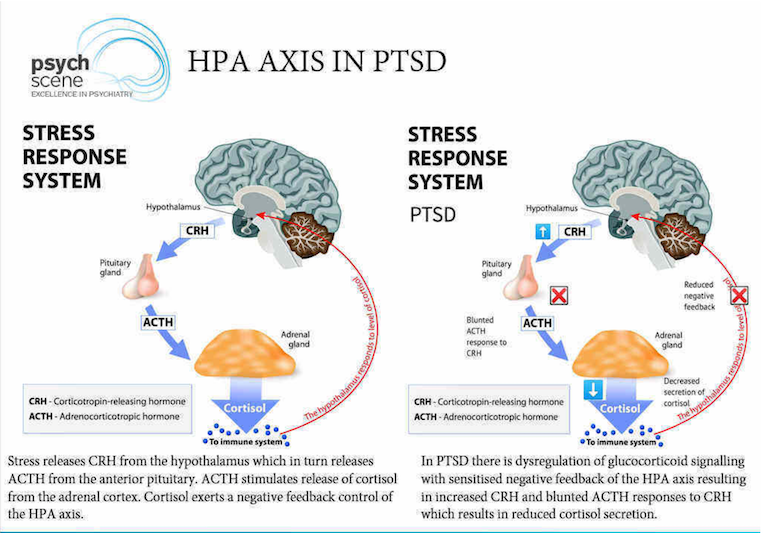PTSD: Biological explanations
Biological etiologies of PTSD
The biological approach argues that both genetics and neurochemistry may explain the origin of PTSD. For this component of the module, you will learn about both the genetic argument and the role of Neuropeptide Y. The biological approach is often considered a reductionist approach to understanding mental health - and it is the basis for medical treatment.
Before completing the module below, please read the section of the textbook called Biological approach to PTSD. When reading this section, please make note of the following important concepts:
- Candidate genes
- Diathesis-stress model
- Homeostasis
- Negative feedback loop
- Neurotransmission
- Reductionism vs holism
- Twin studies
Deepening our understanding
Watch the following video and then answer the questions below. Try to answer the questions by writing a response in your notebook before looking at the "correct" answer that is provided. This will help you to remember the material after you have left this part of the module.
Questions
1. What role does cortisol play in the stress response?
Cortisol provides energy for the stress response. It also works on a negative feedback loop. In healthy human beings, cortisol interacts with receptor sites on the hippocampus. When a certain level of cortisol is reached, the signal is given to shut down the stress response.
2. What are the potential negative effects of chronically high levels of cortisol on the brain?
It increases the rate of activity and the number of neural connections in the amygdala. It also leads to a deterioration of hippocampal cells. The weakening of the hippocampus leads to an impaired ability to control stress. It can also lead to the breaking down of neural connections in the prefrontal cortex, which is important for concentration, decision making and social interaction.
3. The video does not mention PTSD. How could you use this information to explain the symptoms of PTSD?
Research shows that people who have poor regulation of cortisol have a higher risk of PTSD. Evidence suggests that low cortisol at the time of exposure to trauma may predict the development of PTSD and that hypocortisolaemia may be a risk factor for the development of PTSD. The inability to regulate the stress response would explain several of the symptoms of PTSD - including intrusive memories, lack of concentation, and hypervigilance (an overactive amygdalar response).
Negative feedback loops
Cortisol works on a "negative feedback loop." What does that actually mean?
Simply defined, a negative feedback loop is a reaction that causes a decrease in function. In this case, as cortisol levels rise, they then lead to a decrease in the HPA axis response - that is, the stress response.
If you were a zebra, running away from a lion on the savannahs of Africa, cortisol would be breaking down glycogen to provide energy to support your fight or flight response. (Needless to say, zebra usually choose "flight" in this situation). However, once the threat ceases, cortisol levels would remain high until the HPA axis is turned off. Since energy is no longer needed for the stress response, the cortisol levels continue to attach to hippocampal receptor sites (GR) until the threshold is reached and the hypothalamus shuts down the HPA axis response, turning off the release of adrenaline and cortisol.
Researchers believe that it is the failure of this negative feedback loop that leads to stress-related problems - including PTSD. Although the video above explains the effects of high levels of stress on the brain, it is also a problem when we have low levels of cortisol. As you can see in the diagram below, it is actually "low" levels of cortisol secretion during stress which means that the HPA axis is not regulated that leads to the problem. It is hypothesized that either there is a genetic link to this dysfunction of the negative feedback loop, or it is the direct result of the stress which was caused by the trauma.

Biological explanations: Theories and research
Read through the following presentation. In the presentation, you will see two sets of slides to "check for understanding." One set of statements about genetics and one about neurochemistry. For each set of statements, decide whether the statements are true or false. You should be able to justify your position. It is best if you write about your response before checking your work below.
Evaluating theories
The following section looks at how we can evaluate these two theories. Think about the questions below - and then use the flashcards below to see how well you were able to evaluate the theories.
TEACUP and neurobiological theories
One of the ways to evaluate a theory is to use TEACUP:
- Is the theory empirically testable?
- Is there evidence to support the theory? What is the quality of that evidence?
- Are there applications of the theory? How good are those applications?
- What are the constructs that are relevant to the theory? How well can psychologists measure these constructs?
- Is the theory unbiased?
- Does the theory predict behaviour? Or is the theory only explanatory?
Checking for understanding
By now, you should have a good understanding of the strengths and limitations of the theory that PTSD is caused by neurochemical factors. Could you do the same thing now for the theory of genetic vulnerability?
In the box below, write the "evaluation paragraph" in an essay where you have been asked to "Evaluate one biological explanation of one disorder." Assume that you have already written the rest of the essay - that is, you have already explained the theory and described relevant research. Explain two or three evaluation points with regard to the theory - do not try to do all aspects of TEACUP!
Continue to Cognitive explanations of PTSD

 IB Docs (2) Team
IB Docs (2) Team

